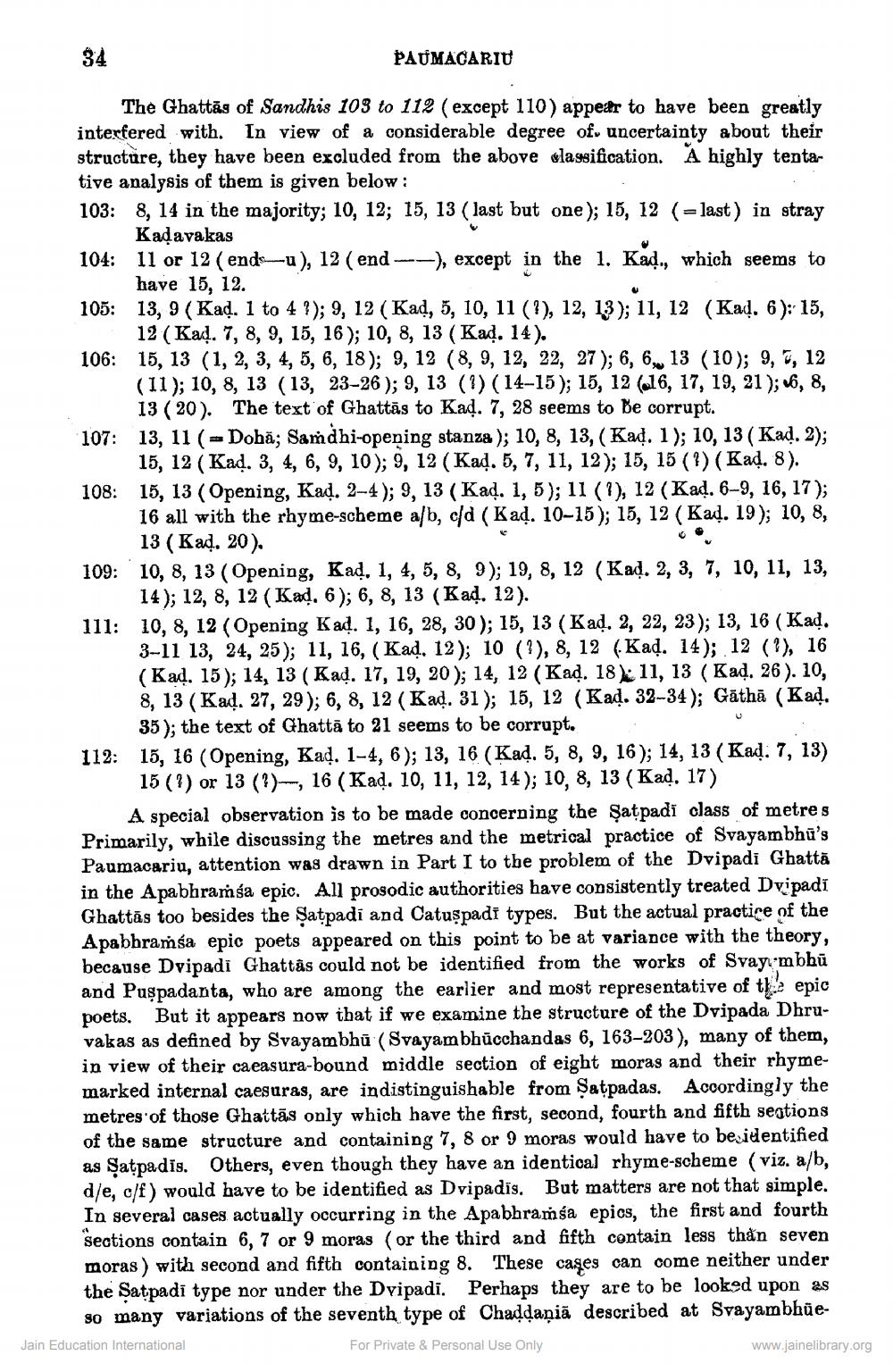________________
34
PAUMACARIU
The Ghattas of Sandhis 103 to 112 (except 110) appear to have been greatly interfered with. In view of a considerable degree of uncertainty about their structure, they have been excluded from the above classification. A highly tentative analysis of them is given below:
103: 8, 14 in the majority; 10, 12; 15, 13 (last but one); 15, 12 (= last) in stray Kaḍavakas
104: 11 or 12 (end-u), 12 (end ——), except in the 1. Kad., which seems to have 15, 12.
U
105: 13, 9 (Kad. 1 to 4 ?); 9, 12 (Kad, 5, 10, 11 (?), 12, 13); 11, 12 (Kad. 6): 15, 12 (Kad. 7, 8, 9, 15, 16); 10, 8, 13 (Kad. 14).
106: 15, 13 (1, 2, 3, 4, 5, 6, 18); 9, 12 (8, 9, 12, 22, 27); 6, 6, 13 (10); 9, 7, 12 (11); 10, 8, 13 (13, 23-26); 9, 13 (1) (14-15); 15, 12 (16, 17, 19, 21); 6, 8, 13 (20). The text of Ghattas to Kad. 7, 28 seems to be corrupt.
107: 13, 11 (= Doha; Samdhi-opening stanza); 10, 8, 13, (Kad. 1); 10, 13 (Kad. 2); 15, 12 (Kad. 3, 4, 6, 9, 10); 9, 12 (Kad. 5, 7, 11, 12); 15, 15 (?) (Kaḍ. 8). 108: 15, 13 (Opening, Kad. 2-4); 9, 13 (Kad. 1, 5); 11 (1), 12 (Kad. 6-9, 16, 17); 16 all with the rhyme-scheme a/b, c/d (Kad. 10-15); 15, 12 (Kad. 19); 10, 8, 13 (Kad. 20).
109: 10, 8, 13 (Opening, Kad. 1, 4, 5, 8, 9); 19, 8, 12 (Kad. 2, 3, 7, 10, 11, 13, 14); 12, 8, 12 (Kad. 6); 6, 8, 13 (Kad. 12).
111: 10, 8, 12 (Opening Kad. 1, 16, 28, 30); 15, 13 (Kad. 2, 22, 23); 13, 16 (Kad. 3-11 13, 24, 25); 11, 16, (Kad. 12); 10 (?), 8, 12 (Kad. 14); 12 (?), 16 (Kad. 15); 14, 13 (Kad. 17, 19, 20); 14, 12 (Kad. 18) 11, 13 (Kad. 26). 10, 8, 13 (Kad. 27, 29); 6, 8, 12 (Kad. 31); 15, 12 (Kad. 32-34); Gathā (Kaḍ. 35); the text of Ghatta to 21 seems to be corrupt.
112: 15, 16 (Opening, Kad. 1-4, 6); 13, 16 (Kad. 5, 8, 9, 16); 14, 13 (Kad. 7, 13)
15 (2) or 13 (?), 16 (Kad. 10, 11, 12, 14); 10, 8, 13 (Kad. 17)
A special observation is to be made concerning the Satpadi class of metre s Primarily, while discussing the metres and the metrical practice of Svayambhu's Paumacariu, attention was drawn in Part I to the problem of the Dvipadi Ghattă in the Apabhramsa epic. All prosodic authorities have consistently treated Dvipadi Ghattas too besides the Satpadi and Catuspadi types. But the actual practice of the Apabhramsa epic poets appeared on this point to be at variance with the theory, because Dvipadi Ghattas could not be identified from the works of Svay mbhū and Puspadanta, who are among the earlier and most representative of the epic poets. But it appears now that if we examine the structure of the Dvipada Dhruvakas as defined by Svayambhu (Svayambhucchandas 6, 163-203), many of them, in view of their caeasura-bound middle section of eight moras and their rhymemarked internal caesuras, are indistinguishable from Satpadas. Accordingly the metres of those Ghattas only which have the first, second, fourth and fifth sections of the same structure and containing 7, 8 or 9 moras would have to be identified as Satpadis. Others, even though they have an identical rhyme-scheme (viz. a/b, d/e, c/f) would have to be identified as Dvipadis. But matters are not that simple. In several cases actually occurring in the Apabhramsa epics, the first and fourth sections contain 6, 7 or 9 moras (or the third and fifth contain less than seven moras) with second and fifth containing 8. These cases can come neither under the Satpadi type nor under the Dvipadi. Perhaps they are to be looked upon as so many variations of the seventh type of Chaddania described at Svayambhue
Jain Education International
For Private & Personal Use Only
www.jainelibrary.org




